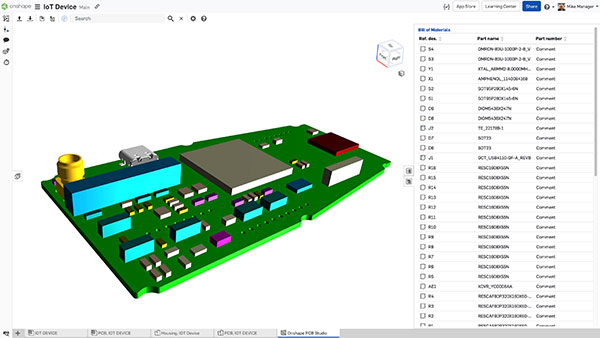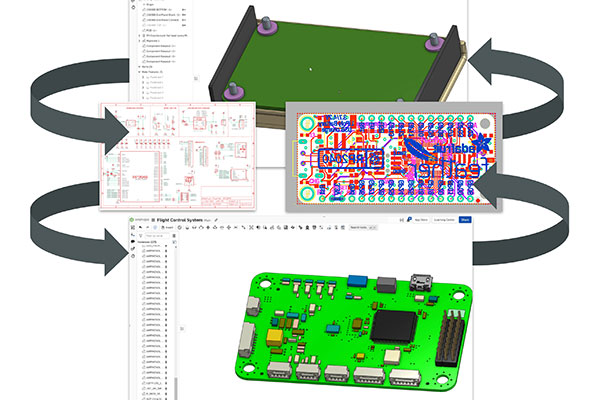
PTC’s PCB Studio allows CAD and ECAD users to easily exchange data and collaborate. The product is available via subscription. Image courtesy of PTC.
Latest News
August 23, 2023
Once an iconic video rental chain, Blockbuster with its “Be kind and rewind” labels was under pressure by 2007, threatened by the newcomer Netflix’s DVD-by-mail business. Eventually, Netflix would undo its own DVD-by-mail business by shifting to the online streaming model. These turbulent changes symbolize the rise of subscription. They are the milestones in the history of business transformation, and gravestones for the now-defunct businesses that had failed to evolve in time.
In the software sector, Microsoft, Salesforce and Adobe began adopting the Software-as-a-Service (SaaS) model. In the case of Adobe, it met with considerable resistance at first. (“Adobe competitors pounce after subscription backlash,” reported CNET in June 2013.) But now, SaaS or subscription appears to be the norm in software.
“Engineering software in general has lagged behind consumer products,” says John McEleney, co-founder of Onshape. McEleney has a good historical perspective because he also co-founded and led SolidWorks, a pioneer in Windows PC-based CAD in the 1990s, later acquired by Dassault Systèmes. Back then, most CAD vendors sold their software as a desktop installation, with annual subscription fees to get regular upgrades. But this is now the outmoded model.
“The world has evolved. Now, the norm is subscription-based pricing, usually associated with cloud-based tools … PTC bit the bullet. Autodesk did as well,” says McEleney.
For PTC, the acquisition of Onshape SaaS CAD, led by a team of former SolidWorks executives, was the turning point. The purchase gave PTC not only the CAD program but also the SaaS platform that would become the linchpin for its shift to SaaS.
Expanding Into ECAD
In its initial incarnation, Onshape was strictly a CAD program, with other complementary functions provided by partners. After PTC acquired it, Onshape began to grow in functions. In May 2020, at the Onshape LIVE virtual conference, PTC revealed it had acquired a software maker called ECAD-MCAD. That was the basis for an integrated ECAD-MCAD bridge for Onshape users. The bidirectional connector, called the Onshape PCB Studio, is now part of Onshape Professional and Enterprise subscription plans.

“Ideally you’d like that [ECAD-MCAD assembly] to be one unified view, kind of like a spreadsheet where a change in one cell updates the results in another,” says McEleney. “Up until now though, that’s been hard because you’ve had silos of applications. ECAD was very separate from MCAD.”
But with the bridge in PCB Studio, a new workflow is possible. “What we’re doing is linking via APIs [application programming interfaces] to allow you to have complete interaction, to be much more iterative and seamless. You’re not sending files back and forth. You’re literally making changes and seeing their implications inside Onshape,” he adds.
In CAD software, the advantage of moving to a cloud-hosted SaaS model is the ability to access additional compute power for rendering and simulation. The exchange of a printed circuit board (PCB) layout or topography is not particularly computationally intensive.
But McEleney points out, “When you’re doing PCB simulation with IC [integrated circuit] simulation, when you’re doing full board simulation to understand path tracing, or logic simulation, it’s computationally intensive.” That’s a factor that will ultimately drive ECAD toward subscription, he suggests.
A similar ECAD-MCAD bridge is also available to PTC Creo software users. Creo was once an installed software, but the company is now making it available as Creo+ SaaS, in the same architecture that powers Onshape.
“Onshape runs on Atlas, but so does our [virtual reality] solution Vuforia. So does our IoT solution ThingWorx. So do some of our generative technology, Creo+ and Windchill+,” says McEleney.
Simulation Drives Subscription
In June 2022, Siemens launched the first SaaS titles for its Xcelerator portfolio, signaling its migration to the cloud-hosted, on-demand model. The company spelled out its X roadmap:
“Step by step, Siemens will transform its entire portfolio of hardware and software to become modular, cloud-connected and built on standard application programming interfaces,” Siemens reported. For collaboration between mechanical and electrical design, Siemens offers an ECAD-MCAD Co-Design module, part of the cloud-based Xcelerator portfolio.
MCAD’s shift to SaaS and subscription is still in progress, with some big-name vendors still offering the desktop option alongside the cloud-hosted option for many of their software titles. ECAD’s transition is right behind it, says Alan Porter, VP of electronics and semiconductor industry, Siemens.
“You see the startups and small businesses moving to the cloud pretty readily because it reduces their IT overhead. But with large enterprises, it’s a much larger ecosystem with different attitudes around security so there’s a lot more analysis on what data needs to be on premise, [and] what can be replaced with cloud-hosted solutions,” says Porter.
Porter’s colleague Puneet Sinha, senior director, battery industry, Siemens, also noticed a similar pattern in his sector.
“A lot of the new startups are not necessarily bound by any legacy infrastructure [built with on-premise solutions], so it’s much easier for them to start with SaaS,” he explains.
Just like their MCAD counterparts, engineers in the electronics sector are also expected to feel the pinch in simulation, nudging them toward SaaS.
“Battery packs have thousands of cells. CFD [computational fluid dynamics] simulation for optimal thermal strategy is very computationally intensive. To remove that heat, you have to account for the chemistry and how it impacts heat generation. And it’s not just about simulating one option because you want to optimize and change different things. That’s where high-performance computing capabilities come into play. If you have a SaaS solution, you don’t necessarily need to have a huge cluster,” says Sinha.
Last year, Zuken launched subscription services for its eCADSTAR, its PCB layout design program with two- and three-dimensional modeling features, simulation tools, MCAD integration and wire harness support.
“We are seeing a growing trend towards time-based licensing in the market for professional engineering software and we are committed to evolving with the market,” says Francesco De Cet, head of European business and operations at Zuken.
Similarly, Altium rolled out a subscription plan for its PCB layout program Altium Designer. The program offers Standard, Pro and Enterprise levels. The ECAD-MCAD Co-Designer is part of the subscription.
More Altium Coverage
More Onshape Coverage
More PTC Coverage
More Siemens Digital Industries Software Coverage
More Zuken Coverage
Subscribe to our FREE magazine, FREE email newsletters or both!
Latest News
About the Author
Kenneth Wong is Digital Engineering’s resident blogger and senior editor. Email him at kennethwong@digitaleng.news or share your thoughts on this article at digitaleng.news/facebook.
Follow DE







